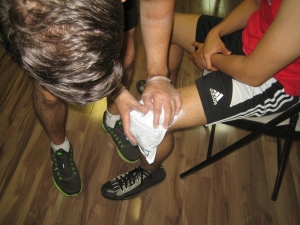Cellulitis is a fairly common skin infection that occurs in the deeper layers of the skin. A streptococcal bacterium is the most common culprit in cases of cellulitis. It is not uncommon for bacteria to be part of the skin’s flora. They do not hinder the skin’s function to protect the body from external factors and do not usually cause harm to their hosts. However, in cases of open cuts, sores, insect bites, burns and even bruises, bacteria may enter the skin and spread to the deeper tissue layers.
Occasionally, cellulitis may occur without a break in the skin, but it is more common in people with a suppressed immune system or diabetes. If left untreated, the bacteria may spread to the lymph nodes and blood, which can be fatal. Complications from cellulitis may also occur in otherwise healthy individuals. Cellulitis is usually treated with antibiotics.
What Causes of Cellulitis?

Cellulitis is commonly caused by the streptococcal bacteria, although another common cause is staphylococcal bacteria. There have also been reported cases of other types of bacteria causing cellulitis. The following are just a few of the many ways to get cellulitis:
- Skin injury, such as cuts, animal or insect bites, burns, bruises, etc.
- Skin problems such as ulcers, psoriasis, eczema, or fungal infections
- Medical conditions, such as diabetes, immunosuppressed diseases, or peripheral arterial disease
- Handling fish, meat, poultry or soil without using gloves
- Fluid buildup in the arms or legs
- Liposuction
- Injection of illegal drugs under the skin
What are the Symptoms of Cellulitis?
Cellulitis can occur anywhere in the body, however, it commonly appears in the legs. For any skin infections that occur in the face or genitalia region, always seek medical attention, regardless of presence of infection. If any of the following symptoms occur, especially in combination, it may be cellulitis:
- Warm, red, swollen and tender infected area
- May progress to redder, more painful or larger area
- Red streaks extending from the infected area
- Fever and chills
- Swollen lymph nodes
What is the Treatment for Cellulitis?
Cellulitis is a serious infection. Mild cases can be treated at home with appropriate medication, however, for severe cases, hospital confinement may be necessary.
- Antibiotics are usually prescribed to treat cellulitis.
- Stay hydrated. Drink plenty of fluids to avoid dehydration.
- Placing an ice pack on the forehead may help cool down the body’s temperature temporarily.
- Dress in light clothing and use only a light cover to avoid increasing body temperature.
How Can Cellulitis Be Prevented?
There are several ways to prevent cellulitis. As always, prevention is better than cure. Although the following hints cannot guarantee complete prevention of cellulitis, they can help reduce risks significantly.
- Maintain good hygiene. Keep the skin clean and use lotion to avoid drying and cracking.
- Treat the skin from any wound or infection immediately.
- If advised by the doctor, take antibiotics regularly.
Understanding cellulitis may help when taking first aid training. To learn of the complications that can be brought by leaving wounds untreated or even improper treatment of wounds may help knowing the importance of applying first aid in every scenario, whether they may seem as minor as a cut or as major as a fractured wound. By joining in first aid courses, cellulitis from wounds and infections may be prevented,
